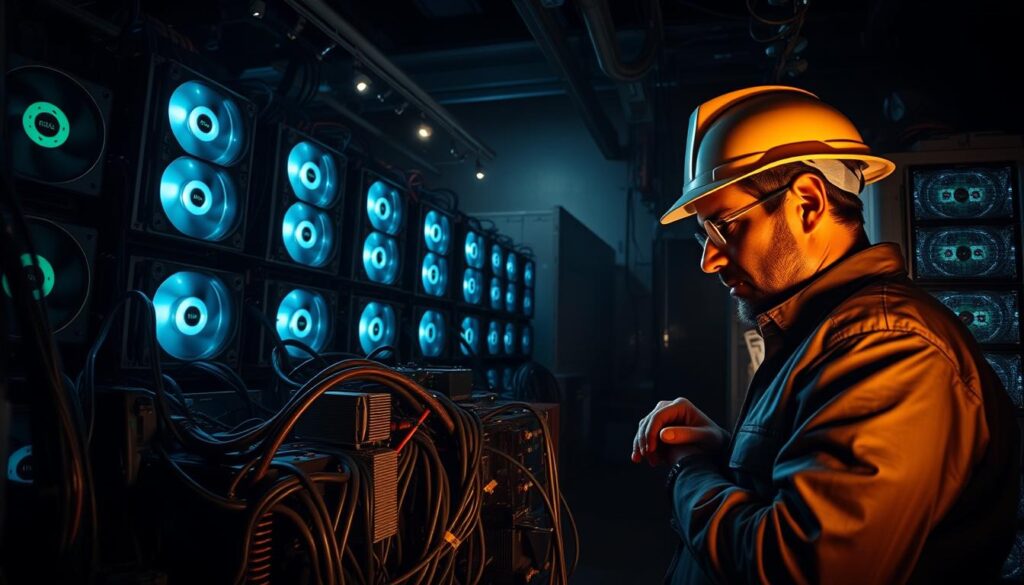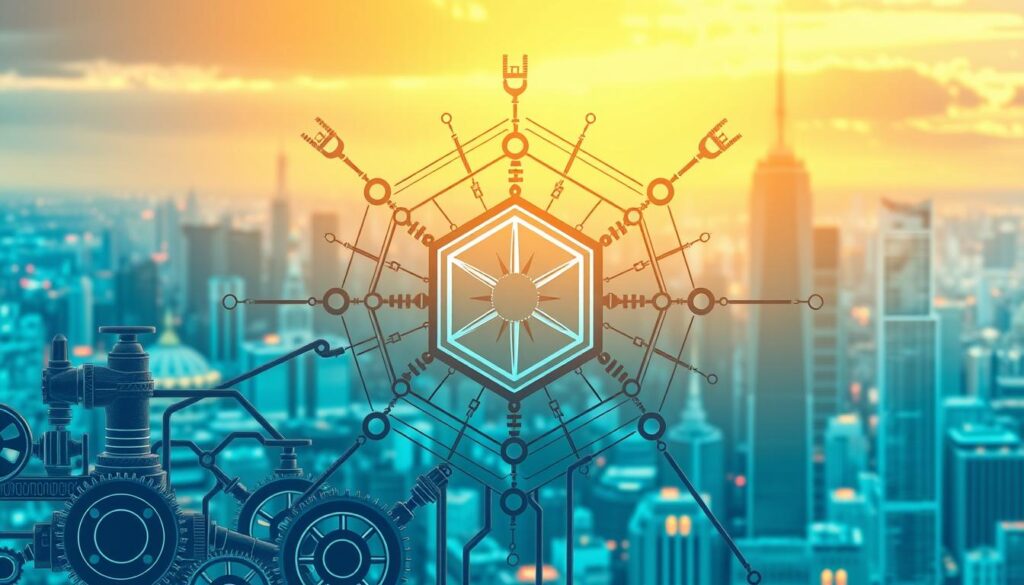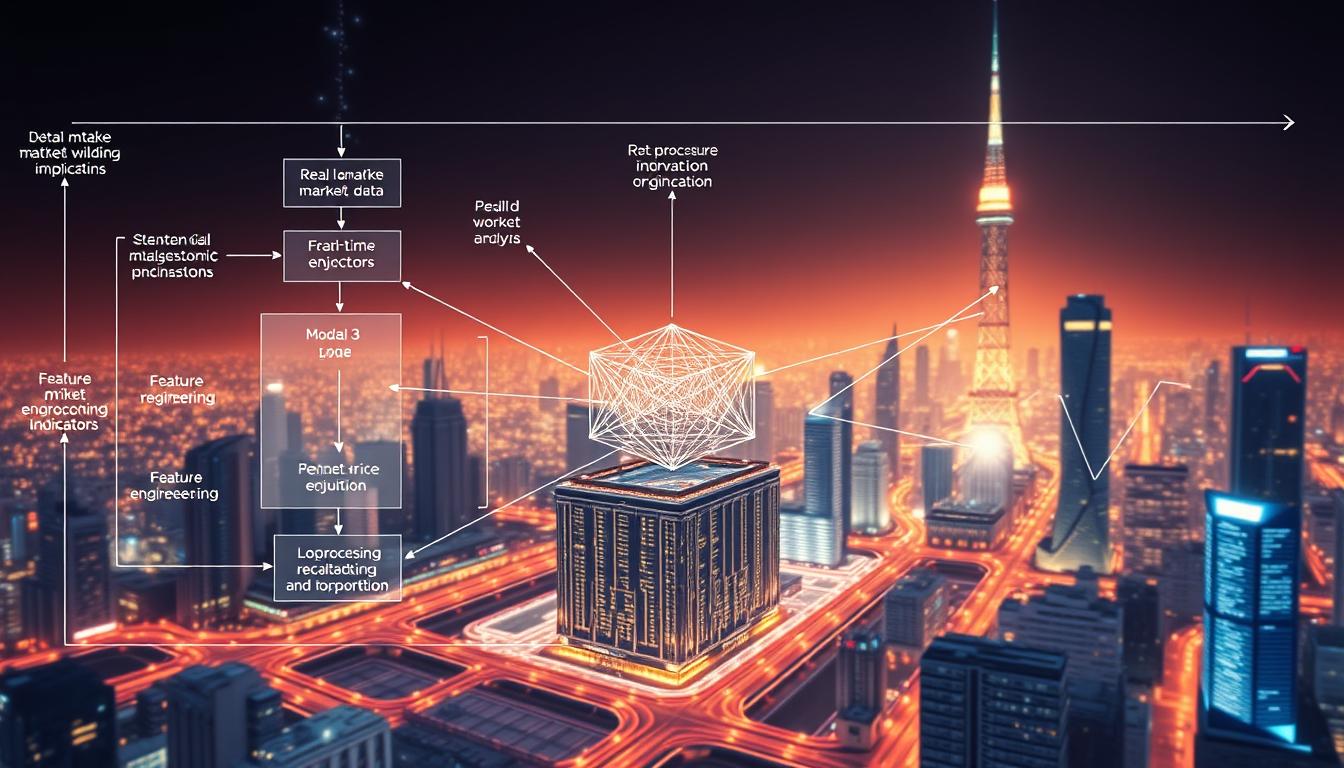Now Reading: A Detailed Blockchain Mining Process Step by Step Guide
- 01
A Detailed Blockchain Mining Process Step by Step Guide
A Detailed Blockchain Mining Process Step by Step Guide

Have you ever wondered how new digital currency enters the economy? The answer lies in a vital computational activity. This foundational mechanism is essential for the operation of major cryptocurrencies like Bitcoin.
At its heart, this activity involves powerful computers solving complex mathematical puzzles. These puzzles are not just random games; they serve a critical purpose. Solving them validates and secures transactions on a public ledger.
The first computer to find the correct solution gets to add a new block of transactions to the chain. As a reward for this effort and for securing the system, the successful participant earns new coins. This creates a transparent and decentralized way to maintain the network’s integrity.
This guide will walk you through the entire operation. We will explore the specialized hardware and software required. You will learn how this system supports a financial network without a central authority.
Key Takeaways
- Cryptocurrency mining is the computational process that validates transactions and secures the network.
- Miners use specialized hardware to solve complex cryptographic puzzles.
- The first miner to solve the puzzle earns new coins as a block reward.
- This process is fundamental for introducing new currency into circulation.
- Mining helps maintain a decentralized and transparent ledger of all transactions.
- Understanding this mechanism is key to grasping how blockchain technology functions.
Introduction to Blockchain Mining
The foundation of cryptocurrency networks relies on a competitive computational activity that validates transactions. This system enables digital currencies to function without central oversight.
Overview of Cryptocurrency Mining
Crypto mining involves specialized computers solving complex mathematical puzzles. Successful participants earn the right to add new transaction blocks to the distributed ledger.
This computational work serves as the backbone of major digital currency systems. It replaces traditional financial intermediaries with decentralized verification.
Purpose and Relevance Today
Mining maintains network security through collective computational effort. It prevents fraud by ensuring only legitimate transactions enter the public record.
The activity continues to attract global participants despite increased competition. It remains essential for maintaining trust in decentralized financial systems.
Understanding this mechanism reveals how crypto networks achieve transparency. Even non-participants benefit from comprehending these foundational principles.
Understanding Bitcoin and Its Fundamentals
Bitcoin stands apart from traditional money due to its foundational principles of scarcity and decentralization. Its design mimics valuable physical assets while operating entirely in the digital realm.
This unique combination gives Bitcoin its distinctive character in the world of finance.
Bitcoin as Digital Gold
Many investors view Bitcoin as “digital gold” because of its hard cap of 21 million coins. This fixed supply creates inherent scarcity, similar to precious metals.
Unlike government-issued currencies, no central authority can create more bitcoins. This protection against inflation is a core part of its value proposition.
The market’s demand solely determines Bitcoin’s price, leading to volatility but also significant appreciation. In December 2024, its value surpassed $100,000, demonstrating strong market confidence.
The following table highlights key similarities between Bitcoin and gold:
| Property | Gold | Bitcoin |
|---|---|---|
| Scarcity | Limited physical supply | Capped at 21 million coins |
| Durability | Does not corrode | Immutable digital record |
| Store of Value | Holds value over time | Potential for long-term appreciation |
Role of Mining in the Network
The activity of bitcoin mining is crucial for introducing new coins into circulation. It is the only way new bitcoins are created.
This computational work also secures the network by validating each transaction. It makes the system resistant to fraud and manipulation.
Miners act as independent auditors for the entire crypto network. Their collective effort maintains the integrity of the payment system without a central party.
The Role of Miners in Securing the Bitcoin Network
Thousands of computers worldwide work together to maintain the integrity of cryptocurrency payment systems. These operators provide essential security for the entire bitcoin network. Their computational effort creates a trustless environment where users can transact safely.
Decentralization and Trust
Miners operate independently across the globe, creating a distributed verification system. This decentralization prevents any single entity from controlling the network. The competitive nature of their work ensures honest behavior is more profitable than attempting fraud.
This system replaces traditional financial intermediaries with mathematical certainty. Participants don’t need to trust each other personally. The economic incentives and cryptographic proofs make honest participation the rational choice for all involved.
Mining as Transaction Verification
When users initiate transactions, these are broadcast to the network for verification. Miners collect these pending transactions and check their validity using cryptographic signatures. This ensures senders have proper authorization and sufficient funds.
The selected transactions are compiled into new blocks for addition to the permanent record. This verification process makes the system resistant to manipulation. It creates a transparent audit trail that anyone can verify.
Hardware and Software Essentials for Mining
Selecting optimal hardware separates profitable ventures from costly experiments. The evolution from basic computers to specialized machines is crucial for understanding modern crypto operations.
Application-Specific Integrated Circuits (ASICs) represent the gold standard for this work. They are built solely for this purpose, offering unmatched efficiency.

ASICs, GPUs, and Their Capabilities
ASICs deliver incredible processing power, measured in terahashes per second. Top models like the Antminer S19 Pro can achieve 335 TH/s.
Their energy efficiency is vital, often around 16 joules per terahash. This directly impacts operational costs and profitability for miners.
Graphics Processing Units (GPUs) offer flexibility for other digital currencies but lag behind for Bitcoin. Central Processing Units (CPUs) are no longer viable due to low hash rates.
| Hardware Type | Primary Use | Hash Rate | Energy Efficiency |
|---|---|---|---|
| ASIC | Bitcoin Mining | Extremely High (100+ TH/s) | Excellent (~16 J/TH) |
| GPU | Altcoin Mining / Gaming | Moderate | Good |
| CPU | General Computing | Very Low | Poor |
Mining Software and Configuration
Specialized software connects your hardware to the network. Programs like CGMiner and BFGMiner are popular open-source options.
Configuration involves setting pool details and wallet addresses. Proper setup ensures your equipment runs at peak efficiency.
Monitoring tools within the software track your hash rate and power consumption. This is essential for managing a successful operation, even a home-based setup.
Blockchain Mining Process Step by Step Guide
Digital currency validation follows a systematic pathway that transforms unconfirmed payments into immutable ledger entries. This mining process involves eight distinct stages that ensure network security and transaction integrity.
The journey begins when miners collect pending transactions from the memory pool. They prioritize payments offering higher fees due to limited space in each new block.
Selected transactions undergo cryptographic hashing to create a Merkle root. This single hash value efficiently represents all payment data within the block.
The core computational work involves finding a special number called a nonce. When combined with block data, it must produce a hash below the current difficulty target.
Specialized hardware performs trillions of calculations per second to discover the correct nonce. The first participant to solve this puzzle broadcasts their solution across the network.
Other nodes then verify the proposed new block meets all consensus rules. Successful validation leads to permanent addition to the chain and reward distribution.
Mining Rewards and the Halving Process
The systematic decrease in block rewards every four years creates Bitcoin’s unique scarcity mechanism. This predictable schedule controls inflation by reducing the rate of new coin creation.

Block Rewards and Transaction Fees
Miners receive compensation through two main sources. The block reward consists of newly created bitcoins awarded for successfully adding transactions to the chain.
Additionally, users pay transaction fees to prioritize their payments. These fees provide an extra income stream for miners beyond the base reward.
The historical progression shows significant reductions. From 50 BTC in 2009, the reward dropped to 3.125 BTC after the 2024 halving.
Impact of Halving on Miner Incentives
Halving events occur approximately every four years, cutting the block reward in half. This reduction forces miners to rely more on transaction fees for profitability.
By around 2140, no more new bitcoins will be created. At that point, fees alone must provide sufficient incentive to maintain network security.
The predictable supply reduction has historically influenced Bitcoin’s value. This scarcity mechanism helps maintain mining profitability despite decreasing rewards.
Mapping the Journey from Transaction to New Block
Every Bitcoin payment embarks on a fascinating journey before achieving permanent status on the public ledger. This pathway ensures each transfer is legitimate and secure.
The lifecycle begins when a user signs a payment with their private key. This digital signature authorizes the movement of funds to a specific recipient address.
Transaction Verification and Selection
Once signed, the payment is broadcast across the peer-to-peer network. Nodes quickly check its basic format and cryptographic signature.
Validated transactions enter a waiting area called the mempool. Here, they compete for attention from miners based on the attached fees.
Miners act as financial curators. They select transactions for the next block, often prioritizing those with higher fees to maximize revenue.
A thorough validation occurs next. Miners confirm the sender has sufficient funds and that the payment follows all consensus rules.
Compiling and Validating New Blocks
Selected payments are organized into a candidate new block. A Merkle root is calculated, creating a unique fingerprint for all the transactions inside.
After the computational work is complete, the proposed new block is shared. Other nodes on the network then perform their own independent validation.
They verify every transaction is legitimate and the block’s structure is correct. This decentralized agreement is crucial for security.
Once accepted, the block is added to the chain. The included transactions are now confirmed. With each subsequent block added, they become practically irreversible.
| Stage | Key Action | Primary Purpose |
|---|---|---|
| Initiation & Signing | User creates and authorizes payment | Define transfer parameters securely |
| Network Broadcast | Transaction is propagated to nodes | Announce the intended payment |
| Mempool Waiting | Transaction awaits miner selection | Compete for block inclusion via fees |
| Block Compilation | Miners assemble candidate block | Prepare transactions for permanent recording |
| Network Validation | Nodes verify the new block | Ensure consensus and prevent fraud |
Exploring Cryptographic Hashes and Nonces
Cryptographic hashing represents the core mathematical challenge that secures transaction validation. This system transforms data into unique digital fingerprints.
Understanding the SHA-256 Hash Function
The SHA-256 algorithm converts any input into a fixed 64-character hexadecimal hash. Each character can be 0-9 or A-F, creating 16^64 possible combinations.

Even tiny input changes produce completely different outputs. “Hello World!” generates one hash, while “Hello World!0” creates another entirely distinct number.
The Critical Role of Nonce in Mining
Miners search for a special number called a nonce (number only used once). They increment this value repeatedly, recalculating the hash each time.
The goal is finding a hash below the network’s target difficulty. This trial-and-error approach ensures network security through computational work.
Every 2,016 block additions, the target difficulty adjusts. This maintains consistent timing for new block creation across the system.
Setting Up a Successful Mining Operation
Launching a successful digital currency operation requires careful strategic planning. Your choice between solo, pool, or cloud-based approaches depends on your budget, technical skill, and goals.
Each method offers a different balance of control, cost, and potential reward. Understanding these options is the first step toward a profitable venture.
Choosing the Right Mining Pool
Most individual participants join a mining pool to combine their computational power. This collaboration significantly increases the chance of earning regular, smaller rewards.
Pools use systems like PPS or PPLNS to distribute earnings based on your contributed work. When you mine bitcoin in a pool, you share the block reward with other miners.
Select a reputable pool with low fees and reliable servers. Consider the payout frequency and the total hash rate of the pool.
Solo Mining Versus Cloud Mining
Solo mining means using your own hardware to try and solve blocks alone. You keep 100% of the reward but face incredibly low odds of success.
This approach demands significant investment in equipment and high energy costs. For most, the infrequent payouts make it an impractical choice.
Cloud mining offers a hands-off alternative. You rent mining capacity from a company, avoiding hardware costs and maintenance.
However, this method introduces risk. You must trust the company’s honesty and operational efficiency.
| Approach | Control Level | Cost & Risk | Best For |
|---|---|---|---|
| Pool Mining | Medium | Lower upfront cost | Most individuals |
| Solo Mining | High | High capital investment | Large-scale operations |
| Cloud Mining | Low | Contract & counterparty risk | Hands-off investors |
Calculate your break-even point carefully before starting. Factor in equipment, electricity, and the current value of the crypto you aim to earn.
Identifying Challenges and Risks in Bitcoin Mining
Before committing resources to computational validation work, understanding the substantial risks involved is essential for making informed decisions. The financial exposure can be significant, with potential rewards balanced against considerable uncertainties.

Financial and Regulatory Concerns
The upfront investment required presents the most immediate hurdle. Specialized equipment costs thousands of dollars with no guaranteed return. Market volatility directly impacts profitability, as price swings can erase margins quickly.
Increasing mining difficulty constantly raises the computational bar. Older hardware becomes obsolete within a short time, forcing costly upgrades. This technological arms race favors large-scale operations.
Energy consumption represents another critical variable. Rising electricity prices can turn profitable ventures into loss-making activities. Miners in regions with expensive power face severe disadvantages.
Regulatory uncertainty adds another layer of risk. Some jurisdictions restrict or ban crypto activities entirely. Legal changes can occur with little warning, jeopardizing operations.
These factors combine to create a challenging environment. Careful research and risk assessment are crucial before entering this competitive space.
Environmental and Economic Considerations
Energy consumption patterns in computational validation work raise important questions about sustainability. The industry faces legitimate concerns about its ecological footprint while balancing economic realities.
Energy Consumption and Sustainability
The computational network requires substantial electricity to function. In 2023, Bitcoin operations consumed approximately 121.13 TWh globally. This represents about 0.44% of worldwide electricity demand.
Critics highlight this significant power usage. Supporters note that energy consumption alone doesn’t determine environmental impact. The source of electricity matters more than the total amount used.
Many operations now seek renewable energy solutions. Solar, wind, and hydroelectric sources are increasingly common. Some companies even use wasted energy like flared natural gas.
| Energy Source | Environmental Impact | Cost Efficiency |
|---|---|---|
| Renewable (Solar/Wind) | Low carbon footprint | Variable based on location |
| Hydroelectric | Very low emissions | Often cost-effective |
| Fossil Fuels | High carbon output | Subject to price volatility |
| Stranded Energy | Utilizes wasted resources | Typically very cheap |
Managing Electronic Waste
Hardware becomes obsolete quickly in this competitive field. Companies must regularly upgrade equipment to maintain efficiency. This creates approximately 24.14 kilotons of electronic waste annually.
The rapid hardware turnover presents a significant waste challenge. Discarded ASICs and related equipment contribute to growing e-waste streams. Proper recycling and disposal methods are essential for sustainability.
Heat generation adds another layer of complexity. Operations require substantial cooling infrastructure. This further increases energy consumption and operational costs.
Industry leaders are implementing innovative solutions. Carbon offset programs and heat recycling initiatives show promise. These efforts aim to balance computational needs with environmental responsibility.
Legal and Regulatory Considerations in the United States
Navigating the legal landscape for cryptocurrency operations requires understanding both federal and state-level requirements. The United States maintains a generally permissive approach to bitcoin mining activities, though compliance obligations vary significantly across jurisdictions.
Compliance and Reporting Requirements
Federal tax treatment represents the most significant consideration for miners. The IRS classifies newly mined crypto as ordinary income at its fair market value upon receipt. This creates immediate tax liabilities regardless of whether coins are sold.
Many operations face dual taxation scenarios. First, mined coins trigger income tax obligations. Second, subsequent sales may generate capital gains taxes if values appreciate.
Business classification affects compliance complexity. Large-scale mining operations often need business registration. This subjects them to additional reporting requirements and potential self-employment taxes.
State-level regulations introduce further variation. Some states offer favorable conditions for crypto activities. Others impose strict energy usage rules or additional licensing requirements.
Proper record-keeping is essential for legal compliance. Miners should document all mining activities, electricity costs, and transaction histories. This ensures accurate reporting within the system.
Consulting with professionals familiar with crypto regulations is advisable. The evolving nature of digital currency mining demands ongoing awareness of regulatory changes.
Future Trends in Bitcoin and Cryptocurrency Mining
The landscape of cryptocurrency validation is undergoing rapid transformation as technological innovations reshape operational capabilities. These advancements promise significant improvements in performance and sustainability across the industry.
Hardware evolution continues at an impressive pace. New ASIC models utilize 5nm and 3nm chip technology for greater computational power.
Evolving Mining Hardware Technologies
Cooling systems represent another frontier for improvement. Immersion cooling technologies submerge equipment in specialized fluids. This approach dramatically reduces heat-related stress on components.
Professional facilities now optimize every aspect of operation. They combine industrial power supplies with advanced monitoring systems. Strategic location near renewable energy sources becomes increasingly common.
The integration of solar and wind power addresses both economic and environmental concerns. This shift supports long-term sustainability for the entire crypto ecosystem.
| Technology Trend | Current Implementation | Future Potential |
|---|---|---|
| ASIC Chip Size | 7nm processors | 3nm technology for better efficiency |
| Cooling Systems | Advanced air cooling | Liquid immersion for maximum heat dissipation |
| Energy Sources | Mixed grid power | Majority renewable integration |
Enhancing Network Security
Growing global participation strengthens the bitcoin network against potential attacks. The increasing hash rate makes network manipulation economically impractical.
Software improvements continuously enhance detection capabilities for unusual activity. These security upgrades work alongside hardware advancements.
The transition toward fee-based economics presents interesting challenges. As block rewards decrease over time, transaction fees must adequately compensate participants. This evolution will test the blockchain’s long-term security model.
Geographical distribution of operations continues to diversify globally. This spreading enhances decentralization and strengthens the overall system against regional disruptions.
Conclusion
Understanding how Bitcoin maintains its security without central control reveals the brilliance of its underlying mechanism. This computational work serves multiple vital functions simultaneously.
Bitcoin mining validates transactions, prevents fraud, and introduces new bitcoins at a predictable rate. The entire system relies on economic incentives to ensure honest participation across the global network.
Successful operations require significant investment and technical expertise. Miners must adapt to changing mining difficulty and price fluctuations over time.
While industrial operations dominate today, pools allow smaller participants to contribute. The process evolves every four years through halvings, testing long-term sustainability.
Even if you don’t plan to mine bitcoin, understanding this crypto foundation reveals how decentralized trust works. The blockchain represents a remarkable achievement in digital systems.
FAQ
What is the main purpose of crypto mining?
The primary purpose is to secure the network and verify transactions. Miners use powerful hardware to solve complex math problems. This work adds new blocks to the chain, preventing fraud and ensuring the system’s integrity without a central authority.
How often does the Bitcoin halving event occur?
The halving happens approximately every four years. This event cuts the block reward given to miners in half. It is a built-in feature to control the supply of new bitcoins, influencing miner incentives and the overall crypto economy.
Can I use a regular computer to mine Bitcoin today?
It is not practical anymore. The mining difficulty is now so high that specialized hardware like ASIC miners from companies like Bitmain is required. These devices offer the immense hash power needed to compete effectively and have a chance to earn rewards.
What is a mining pool and why is it important?
A mining pool is a group of miners who combine their computational power. By working together, they increase their chances of solving a block and earning the reward. Pools like F2Pool then distribute the earnings among members, providing more consistent payouts than solo mining.
What happens to transaction fees after all bitcoins are mined?
Once the 21 million bitcoin cap is reached, transaction fees will become the primary incentive for miners. These fees, paid by users to prioritize their transactions, will be essential for maintaining network security and ensuring miners continue their verification work.
How does mining difficulty adjust over time?
The network automatically adjusts the mining difficulty roughly every two weeks. This ensures that the average time to find a new block stays near 10 minutes, regardless of the total hash power on the network. If more miners join, the difficulty increases to maintain this balance.
Are there significant tax implications for miners in the U.S.?
Yes. The IRS treats mined cryptocurrency as taxable income. The fair market value of the coins at the time they are received must be reported. Any subsequent sale may also trigger capital gains tax, so accurate record-keeping is crucial for compliance.















